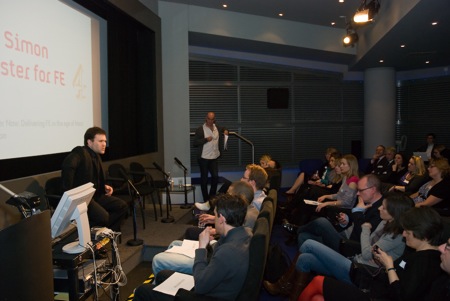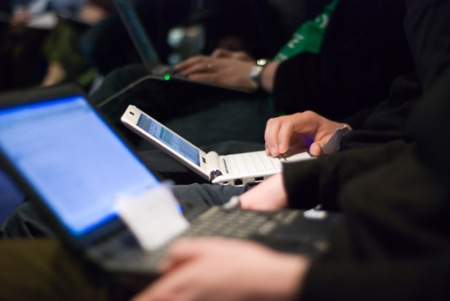
Today DIUS and Becta held a conference hosted by Channel 4 in London under the banner “All Together Now: Delivering Further Education in an era of mass participation“. The event was for policy makers, FE professionals and providers to consider the implications and potential of this new wave of media and technology innovation, learn from the people who have been pioneering their use and network, debate and develop how they could be used to enrich the learner experience in FE. Props to Michelle and Lucy in particular along with Steve and the Becta crew for their hard work putting together a great day.
It was primarily about immersion and challenge. As our minister Sion Simon put it, it reflected the fact that government should learn from the people who know better than we do what young people are doing with these tools:
http://altogethernow.ning.com/video/video
The core online platform was a Ning group set up by Becta to share materials from the event and continue the discussion. Ning is a great and flexible tool, which served us well on the day.
For my team – under the expert tutelage of Dave Briggs – this event was a good opportunity to practice our social reporting skills, and apply a number of different approaches to see what works best for us. Specifically, we were looking at capturing pictures and video from the event, cover some of the main themes and sessions in blog form, try out some podcasting and cover the event on Twitter for those unable to be there. We’ll debrief as a team and review tomorrow, but my topline reflections were:
- practising the skills makes you think about the value and purpose of social reporting: ultimately there’s value in four areas: you’re creating an engaging record of a valuable event for the future; you’re widening the reach of the event to people who can’t be there; you’re providing platforms to extend the discussion for the participants, and providing a backchannel and way for participants to take part in the reporting too; and you’re facilitating (potentially) live interaction between the physical and online audiences. Phew.
- what to capture? Traditional event reporting focuses on the speakers, whereas social reporting is often about the audience. Capturing both the highlights from the speakers and the audience reactions is a tall order, even with a team of social reporters.
- discussion online: before, during or after? Tools like Ning come with built in commenting, blogs and forums. With an event like the UKGovWeb barcamp, the discussion was quite active online in advance of the event; the UKYouthOnline barcamp is still talking online six months after the event. Neither of those saw a lot of activity during the event itself; by dedicating a social reporter to the task of rapid editing and uploading (a social editor?) we saw a lot more activity on the site during the event itself, including a bit of discussion during the event too – plus the Twitter activity.
- production values vs speed: I think it was Adam Gee, a commissioning editor from Channel 4, who said in a Q&A session that production values of online media matter less to young people than the ability to access streams, when and where they want. Dave’s rapid video editing, and Rhys’ quick photo retouching, meant that we got stuff up quickly even if it had some rough edges. The value of this content is in having it available, not necessarily in very polished form.
- power of Twitter: like everyone, I’m finding Twitter more and more useful these days. But if you’re live tweeting, you realise just how powerful a tool it is. The ability to rapidly and simultaneously publish and send private messages, share content from others and provide background for readers in the form of extra links and Twitter usernames, is really amazing.
- audioboo podcasting: I’ve been an audioboo fan for about 36 hours now. The podcast I recorded was in a noisy concrete-lined room, and yet it came out really well. Definitely my favourite iPhone app of the moment, and I can see lots of uses for it in future.
- logistics: most of the social reporting posts I’ve read focus on the gear (netbooks, cameras, audio recorders etc), and it’s true that that’s a big part of it. But equally important are the little logistical things: having access to reliable wifi (we eventually fixed that around lunchtime, sorry guys), having lots of 4-way extension leads, assigning clear roles to make sure the important content got captured, and drawing on the varied skills of your social reporters. We were in the lovely position of having a speechwriter, an ethnographer, a press officer/photographer, a couple of geeks, a community manager and a couple of stakeholder/events people in our reporting team today.
Is social reporting just a rather self-indulgent pursuit in these straitened times? I don’t think it is – we did a lot of things right today and can learn some useful tips and tricks for the future to help ensure we get more value out of events like this, ensuring that more people can benefit both during and afterwards. And it’s rather fun too.

Photo credits: Rhys Stacker, DIUS

Comments
Shouldn’t Ning not working from most mobile phones disqualify it from social reporting?
Great blog Steph, and sorry I didn’t get to say hi in person on the day – you looked far too busy!
I was involved in this event with my Becta hat on and thought it worth responding to MJ Ray’s comment about Ning on mobile phones. You’re absolutely right – Ning isn’t great (yet) on mobile devices. I use both a blackberry and an iPhone. It’s wonderful on iPhone, but too clunky on blackberry. I think we need to be careful when using platforms, or in how we use them, to ensure users aren’t excluded. For example, I too love audioboo now but it currently is only good for iPhone users to really engage with.
Getting back to the point though, I was involved in setting up the Ning site for this event and I think it’s fair to say that that space really only works to hold the content together and provide ongoing reflection. The real value of social reporting is in it’s cross-platform nature. Social reporting when done well should never be just about one space. So, to some extent it doesn’t matter that Ning isn’t great on all mobiles, as the event was reported across twitter, audioboo and videoboo, and of course the power to grab RSS feeds also makes it more accessible. On the day, wi-fi issues meant I couldn’t access the ning site on my laptop easily, and mobile phone reception in the basement prevented the 3G card from working, but I still felt part of the online discussion through simply engaging through Twitter.
I think it’s also worth pointing out that while Ning is a little sucky accessibility-wise, it does at least allow the easy upload of content from a mobile to the site, thus enabling more people to get involved in the conversation that way.
This is still an area of experimentation and playing with stuff to see what works best. Am sure it will be a while before we get it right.
‘@Tracy: thanks for stopping by, and for your work to set up the Ning site. I think it worked really well, and better still, it continues to work after the event. You’re quite right about the multiple platforms – people were creating content on Nokia N95s, iPhones, XP- and Ubuntu-powered netbooks, DSLRS – and quite a lot of paper notepads too. Ning brings this together, but most of it lives in other spaces online.
@Dave: good work that man. Hope you didn’t find the role of ‘social editor’ too dull. I wonder if the next step is to involve the audience more in the reporting process – setting the expectation at the start of the day, if not before, that we’re all there to record and share our learnings, and that some output will be expected of everybody – even if it’s just a few comments?
[…] A spot of social reporting: what I learned at Helpful Technology Learning from event/social reporting (tags: socialmedia reporting socialreporting learning conference) […]